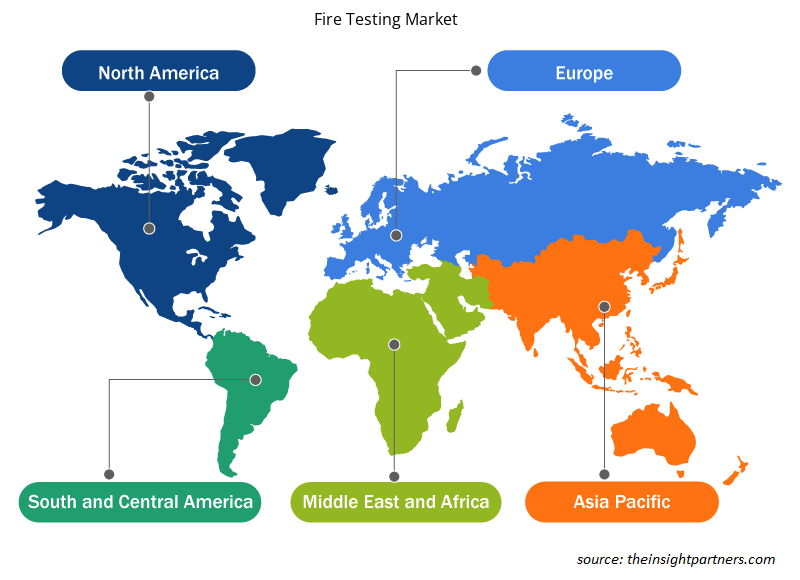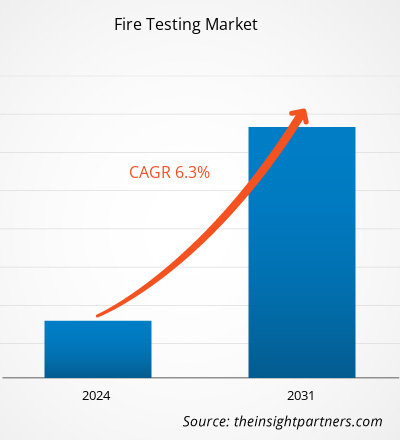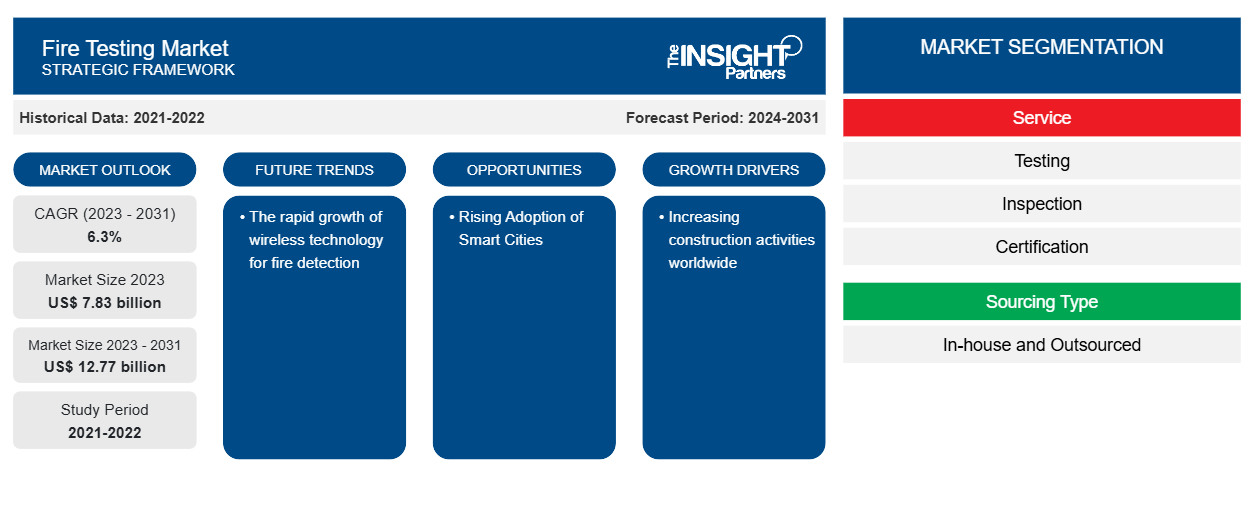Se proyecta que el tamaño del mercado de pruebas de incendios alcance los 12.770 millones de dólares estadounidenses en 2031, frente a los 7.830 millones de dólares estadounidenses en 2023. Se espera que el mercado registre una CAGR del 6,3 % entre 2023 y 2031. Es probable que el rápido crecimiento de la tecnología inalámbrica para la detección de incendios siga siendo una tendencia clave en el mercado de pruebas de incendios.
Análisis del mercado de pruebas de fuego
La modernización y los avances tecnológicos en el sector de la construcción y los nuevos desarrollos inmobiliarios y de construcción son algunos de los principales factores que impulsan el crecimiento del mercado en todo el mundo. Además, la industria minorista también está impulsando una creciente demanda de sistemas de prevención de incendios debido al marcado aumento en el número de supermercados, hipermercados y centros comerciales en las áreas urbanas. Además, los gobiernos de la mayoría de los países se están concentrando en promulgar leyes y normas más estrictas relacionadas con la seguridad de los edificios y la protección contra incendios, lo que se espera que cree una oportunidad para el crecimiento del mercado en el período previsto.
Descripción general del mercado de pruebas de fuego
Las pruebas de resistencia al fuego son un método para determinar los criterios mínimos de rendimiento de los productos de protección contra incendios y establecer criterios basados en la tasa de liberación de calor, la tasa de propagación de la llama, la temperatura, la resistencia al fuego, el área cubierta y otros factores. Para la instalación en el sitio, todos los productos deben tener certificación de protección contra incendios. Como resultado, las pruebas se han convertido en un componente esencial de las leyes de seguridad de los consumidores y de la construcción en todo el mundo. El mercado mundial de pruebas de resistencia al fuego está siendo impulsado por el uso creciente de sistemas de seguridad en las industrias y la automatización de edificios .
Personalice este informe según sus necesidades
Obtendrá personalización en cualquier informe, sin cargo, incluidas partes de este informe o análisis a nivel de país, paquete de datos de Excel, así como también grandes ofertas y descuentos para empresas emergentes y universidades.
-
Obtenga las principales tendencias clave del mercado de este informe.Esta muestra GRATUITA incluirá análisis de datos, desde tendencias del mercado hasta estimaciones y pronósticos.
Factores impulsores y oportunidades del mercado de pruebas de fuego
Aumento de las actividades de construcción en todo el mundo
Se prevé que el aumento de las actividades de construcción impulse el crecimiento del mercado de pruebas de incendio en los próximos años. Los trabajos de construcción incluyen una amplia gama de tareas, como limpiar el sitio, excavar, colocar los cimientos, erigir elementos estructurales, instalar el sistema y agregar los toques finales. Tanto en la construcción residencial como comercial, las pruebas de incendio se utilizan para evaluar y mejorar la combustibilidad de los materiales y estructuras de construcción, lo que garantiza el cumplimiento de las normas de seguridad y elimina cualquier amenaza de incendio. Por lo tanto, se espera que el uso creciente de pruebas de incendio en las actividades de construcción impulse el crecimiento del mercado de pruebas de incendio.
Creciente adopción de ciudades inteligentes
La adopción de la idea de ciudad inteligente está aumentando en todo el mundo. Una ciudad inteligente es aquella que utiliza la tecnología de la información y la comunicación (TIC) para aumentar la producción, informar a la población y mejorar la calidad de los servicios públicos y el bienestar. En las ciudades inteligentes, las pruebas de detección de incendios se utilizan para pronosticar y detectar humo e incendios de forma temprana, lo que puede mejorar significativamente la seguridad pública al reducir los daños a gran escala, lo que se espera que cree una oportunidad para el crecimiento del mercado de pruebas de detección de incendios en el período previsto.ICT) to increase production, inform the populace, and improve the quality of public services and welfare. In smart cities, fire testing is used to forecast and detect smoke and fire early on, which can significantly improve public safety by reducing large-scale damage, which is expected to create an opportunity for the growth of the fire testing market in the forecasted period.
Análisis de segmentación del informe de mercado de pruebas de fuego
Los segmentos clave que contribuyeron a la derivación del análisis del mercado de pruebas de fuego son el servicio, el tipo de abastecimiento y la aplicación.
- Según el servicio, el mercado de pruebas de incendio se segmenta en pruebas, inspección y certificación. El segmento de pruebas tuvo una mayor participación de mercado en 2023.
- Según el tipo de abastecimiento, el mercado se segmenta en interno y externo. El segmento interno tuvo una mayor participación de mercado en 2023.
- Según la aplicación, el mercado está segmentado en edificación y construcción, automoción, industria y fabricación, bienes de consumo y venta minorista, aeroespacial y defensa, entre otros. El segmento de edificación y construcción tuvo una mayor participación de mercado en 2023.
Análisis de la cuota de mercado de pruebas de fuego por geografía
El alcance geográfico del informe del mercado de pruebas de fuego se divide principalmente en cinco regiones:América del Norte, Asia Pacífico, Europa, Medio Oriente y África, y América del Sur/América del Sur y Central.
Se prevé que Asia Pacífico sea testigo de un crecimiento significativo en el mercado de pruebas de incendios. El mercado en esta región está segmentado en Australia, China, India, Japón, Corea del Sur y el resto de APAC. Es probable que la creciente industrialización y urbanización de la región, en particular en China, Japón e India, impulse la expansión del mercado. La construcción de áreas comerciales e industriales, como supermercados, centros comerciales, multicines, inmuebles y edificios de oficinas, se está expandiendo rápidamente en estas economías en ascenso. Este crecimiento está impulsando la demanda de servicios de pruebas de incendios. Para reducir el peligro y los daños de los incendios, las empresas están invirtiendo fuertemente en infraestructura y pruebas de incendios, lo que se prevé que impulse la expansión del mercado durante el período de proyección.
Perspectivas regionales del mercado de pruebas de fuego
Los analistas de Insight Partners explicaron en detalle las tendencias y los factores regionales que influyen en el mercado de pruebas de incendios durante el período de pronóstico. Esta sección también analiza los segmentos y la geografía del mercado de pruebas de incendios en América del Norte, Europa, Asia Pacífico, Oriente Medio y África, y América del Sur y Central.

- Obtenga datos regionales específicos para el mercado de pruebas de fuego
Alcance del informe de mercado de pruebas de fuego
| Atributo del informe | Detalles |
|---|---|
| Tamaño del mercado en 2023 | 7.830 millones de dólares estadounidenses |
| Tamaño del mercado en 2031 | US$ 12,77 mil millones |
| CAGR global (2023 - 2031) | 6,3% |
| Datos históricos | 2021-2022 |
| Período de pronóstico | 2024-2031 |
| Segmentos cubiertos |
Por servicio
|
| Regiones y países cubiertos |
América del norte
|
| Líderes del mercado y perfiles de empresas clave |
|
Densidad de actores del mercado: comprensión de su impacto en la dinámica empresarial
El mercado de pruebas de fuego está creciendo rápidamente, impulsado por la creciente demanda de los usuarios finales debido a factores como la evolución de las preferencias de los consumidores, los avances tecnológicos y una mayor conciencia de los beneficios del producto. A medida que aumenta la demanda, las empresas amplían sus ofertas, innovan para satisfacer las necesidades de los consumidores y aprovechan las tendencias emergentes, lo que impulsa aún más el crecimiento del mercado.
La densidad de actores del mercado se refiere a la distribución de las empresas o firmas que operan dentro de un mercado o industria en particular. Indica cuántos competidores (actores del mercado) están presentes en un espacio de mercado determinado en relación con su tamaño o valor total de mercado.
Las principales empresas que operan en el mercado de pruebas de fuego son:
- Applus+
- Oficina Veritas
- DEKRA
- Tecnología de materiales de elementos
- Grupo Intertek plc
- SGS SA
Descargo de responsabilidad : Las empresas enumeradas anteriormente no están clasificadas en ningún orden particular.

- Obtenga una descripción general de los principales actores clave del mercado de pruebas de fuego
Noticias y desarrollos recientes del mercado de pruebas de fuego
El mercado de pruebas de fuego se evalúa mediante la recopilación de datos cualitativos y cuantitativos posteriores a la investigación primaria y secundaria, que incluye publicaciones corporativas importantes, datos de asociaciones y bases de datos. A continuación, se incluye una lista de los avances del mercado:
- Jensen Hughes, líder mundial en ingeniería, consultoría y tecnología que hacen que el mundo sea seguro, protegido y resiliente, anunció que ha adquirido Warringtonfire Australia, una empresa líder en Australia en materia de consultoría de ingeniería de seguridad contra incendios y pruebas de incendios, de Element Materials Technology. Esta adquisición estratégica amplía la presencia de la empresa global en rápido crecimiento en Australia y ayuda a posicionar a la empresa excepcionalmente bien para una futura expansión en Australia y Nueva Zelanda, así como a nivel regional. (Fuente: Jensen Hughes, comunicado de prensa, 2023)
- Intertek, un proveedor de garantía de calidad total para industrias de todo el mundo, anunció el lanzamiento de un nuevo servicio local para pruebas de resistencia al fuego y certificación de productos de construcción en Arabia Saudita para satisfacer la creciente demanda de pruebas de resistencia al fuego por parte de los clientes de la región. Intertek es el primer organismo de certificación que ofrece pruebas de resistencia al fuego de extremo a extremo y certificación de materiales de construcción en Arabia Saudita. El nuevo servicio ofrece pruebas y certificación de productos de construcción como puertas cortafuegos, paredes, mamparas acristaladas y techos. (Fuente: Intertek, comunicado de prensa, 2021)
Informe de mercado sobre pruebas de fuego: cobertura y resultados
El informe “Tamaño y pronóstico del mercado de pruebas de fuego (2021-2031)” proporciona un análisis detallado del mercado que cubre las siguientes áreas:
- Tamaño del mercado y pronóstico a nivel global, regional y nacional para todos los segmentos clave del mercado cubiertos bajo el alcance
- Dinámica del mercado, como impulsores, restricciones y oportunidades clave
- Principales tendencias futuras
- Análisis detallado de las cinco fuerzas de Porter y PEST y FODA
- Análisis del mercado global y regional que cubre las tendencias clave del mercado, los principales actores, las regulaciones y los desarrollos recientes del mercado.
- Análisis del panorama de la industria y de la competencia que abarca la concentración del mercado, el análisis de mapas de calor, los actores destacados y los desarrollos recientes
- Perfiles detallados de empresas
- Análisis histórico (2 años), año base, pronóstico (7 años) con CAGR
- Análisis PEST y FODA
- Tamaño del mercado, valor/volumen: global, regional y nacional
- Industria y panorama competitivo
- Conjunto de datos de Excel
Informes recientes
Informes relacionados
Testimonios
Razón para comprar
- Toma de decisiones informada
- Comprensión de la dinámica del mercado
- Análisis competitivo
- Información sobre clientes
- Pronósticos del mercado
- Mitigación de riesgos
- Planificación estratégica
- Justificación de la inversión
- Identificación de mercados emergentes
- Mejora de las estrategias de marketing
- Impulso de la eficiencia operativa
- Alineación con las tendencias regulatorias























 Obtenga una muestra gratuita para - Mercado de pruebas de fuego
Obtenga una muestra gratuita para - Mercado de pruebas de fuego